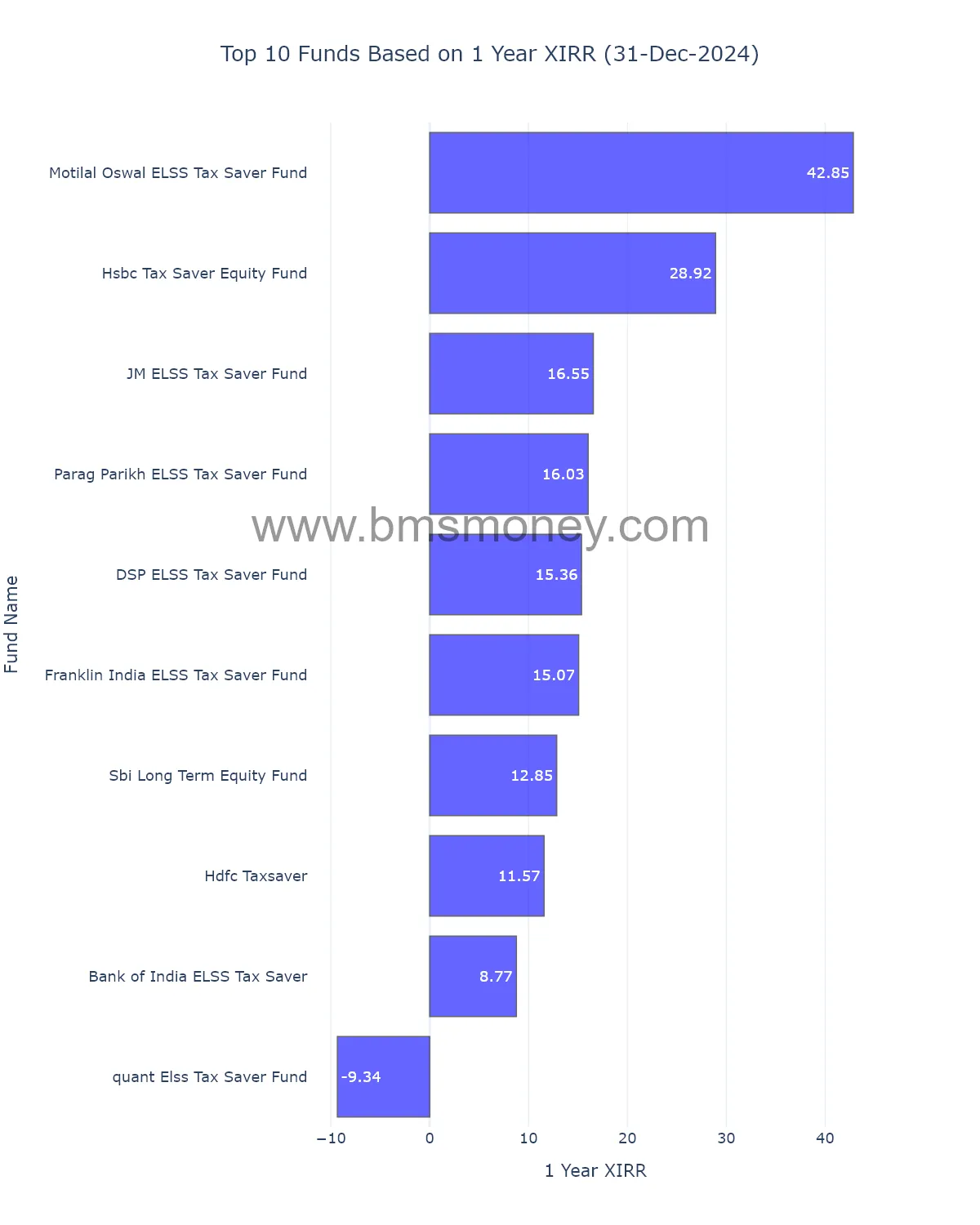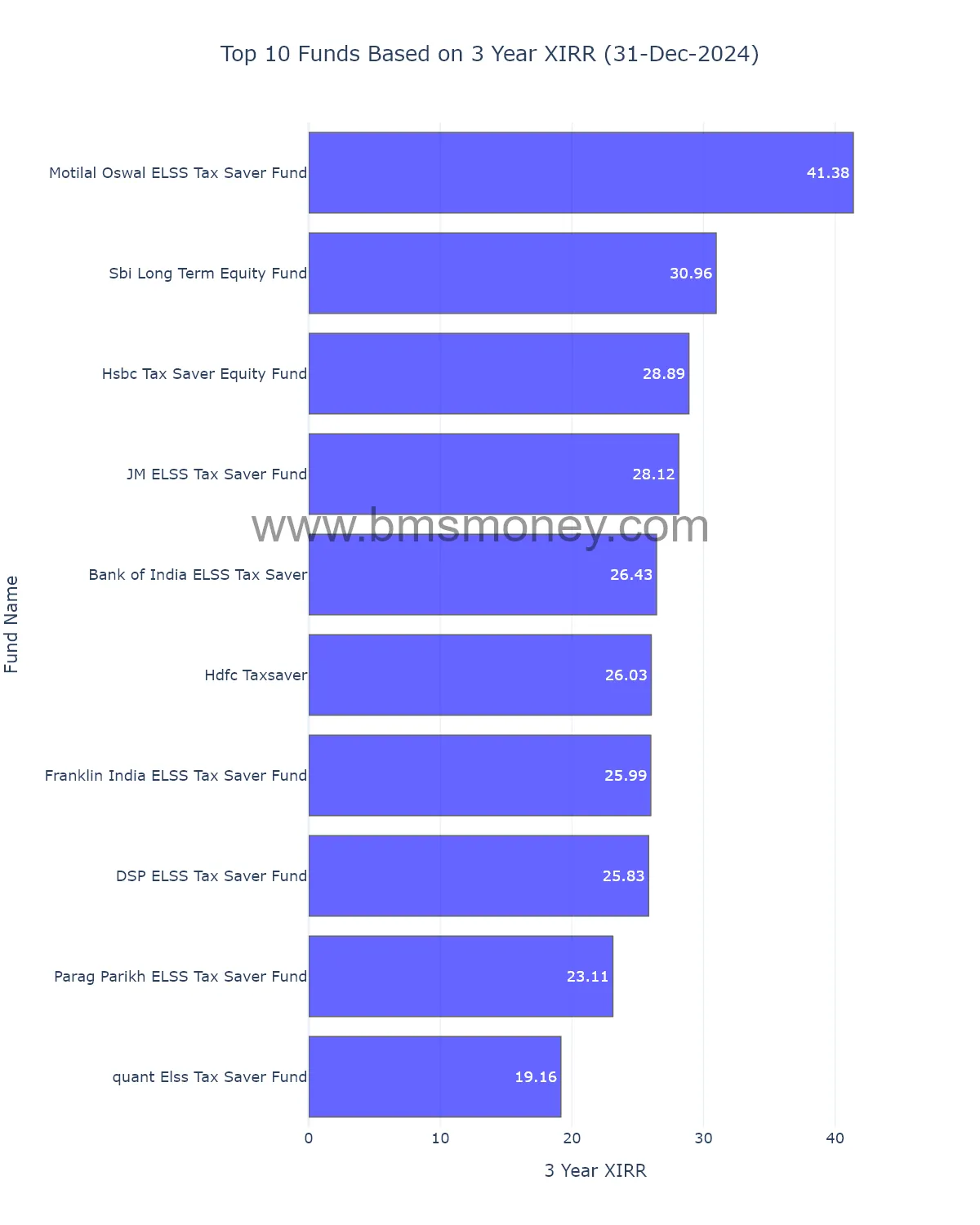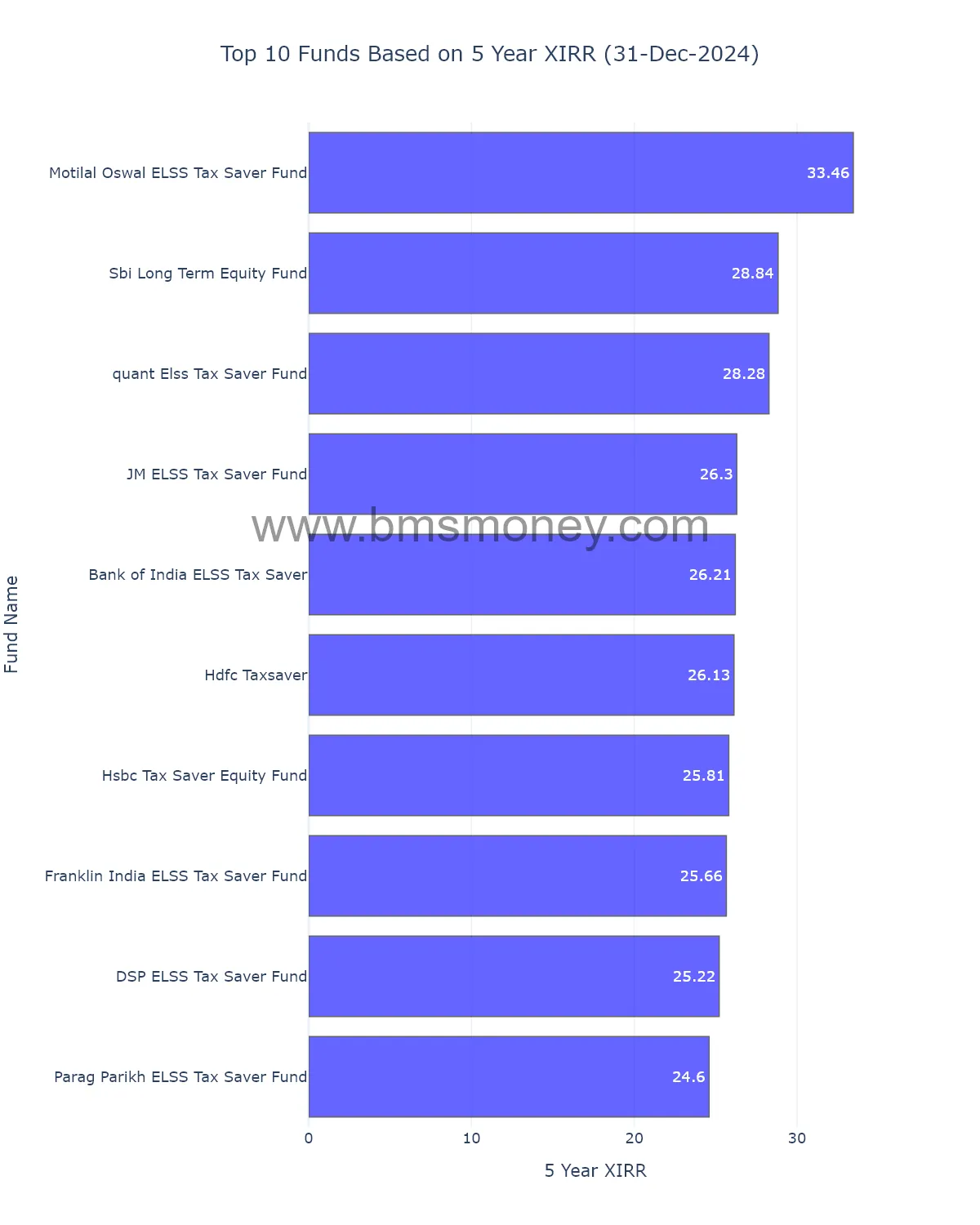- Motilal Oswal ELSS: Highest 5-year XIRR at 33.46%, strong risk-adjusted returns, ideal for growth-focused investors.
- SBI Long Term Equity: 5-year XIRR of 28.84%, low volatility, suitable for moderate-risk, long-term investors.
The table below shows the return performance of ELSS funds on 31 December 2024.
| Fund Name | 5Y XIRR | 5Y XIRR Percentile | 3Y XIRR | 3Y XIRR Percentile | 1Y XIRR | 1Y XIRR Percentile | 1Y Return | 3Y Return | 5Y Return |
|---|---|---|---|---|---|---|---|---|---|
| Motilal Oswal ELSS Tax Saver Fund | 33.46 | 100.00 | 41.38 | 100.00 | 42.85 | 100.00 | 48.38 | 28.80 | 25.81 |
| Sbi Long Term Equity Fund | 28.84 | 96.97 | 30.96 | 96.97 | 12.85 | 60.98 | 28.03 | 24.95 | 25.20 |
| quant Elss Tax Saver Fund | 28.28 | 93.94 | 19.16 | 30.30 | -9.34 | 2.44 | 9.91 | 18.50 | 32.38 |
| JM ELSS Tax Saver Fund | 26.30 | 90.91 | 28.12 | 87.88 | 16.55 | 82.93 | 30.05 | 20.56 | 22.69 |
| Bank of India ELSS Tax Saver | 26.21 | 87.88 | 26.43 | 84.85 | 8.77 | 31.71 | 22.57 | 18.71 | 25.96 |
| Hdfc Taxsaver | 26.13 | 84.85 | 26.03 | 81.82 | 11.57 | 53.66 | 22.09 | 22.05 | 21.35 |
| Hsbc Tax Saver Equity Fund | 25.81 | 81.82 | 28.89 | 93.94 | 28.92 | 97.56 | 34.26 | 19.86 | 21.41 |
| Franklin India ELSS Tax Saver Fund | 25.66 | 78.79 | 25.99 | 78.79 | 15.07 | 73.17 | 23.22 | 20.18 | 21.54 |
| DSP ELSS Tax Saver Fund | 25.22 | 75.76 | 25.83 | 72.73 | 15.36 | 75.61 | 24.51 | 20.06 | 22.35 |
| Parag Parikh ELSS Tax Saver Fund | 24.60 | 72.73 | 23.11 | 63.64 | 16.03 | 80.49 | 21.37 | 18.69 | 24.53 |



The table below shows the risk and risk-adjusted performance of ELSS funds for the month ending 29 November 2024.
| Fund Name | Sharpe Ratio | Sortino Ratio | Treynor Ratio | Standard Deviation | Semi Deviation | Max Drawdown | Average Drawdown | VaR 1Y |
|---|---|---|---|---|---|---|---|---|
| Motilal Oswal ELSS Tax Saver Fund | 1.15 | 0.64 | 0.17 | 14.39 | 9.95 | -16.54 | -6.81 | -14.63 |
| quant Elss Tax Saver Fund | 0.79 | 0.40 | 0.13 | 16.37 | 11.71 | -12.73 | -6.07 | -20.35 |
| Sbi Long Term Equity Fund | 1.09 | 0.57 | 0.16 | 14.33 | 10.37 | -11.56 | -5.67 | -16.26 |
| Bank of India ELSS Tax Saver | 0.73 | 0.39 | 0.11 | 14.72 | 10.25 | -16.59 | -5.89 | -15.72 |
| Hdfc Taxsaver | 1.12 | 0.60 | 0.16 | 12.28 | 8.76 | -6.86 | -4.31 | -14.39 |
| JM ELSS Tax Saver Fund | 0.75 | 0.40 | 0.11 | 14.81 | 10.21 | -16.28 | -6.27 | -17.67 |
| DSP ELSS Tax Saver Fund | 0.76 | 0.40 | 0.11 | 13.92 | 9.83 | -12.45 | -5.78 | -17.85 |
| Franklin India ELSS Tax Saver Fund | 0.76 | 0.38 | 0.11 | 13.45 | 9.72 | -13.43 | -7.18 | -18.53 |
| Hsbc Tax Saver Equity Fund | 0.72 | 0.37 | 0.11 | 13.69 | 9.71 | -13.80 | -4.45 | -17.04 |
| ITI ELSS Tax Saver Fund | 0.72 | 0.38 | 0.11 | 13.77 | 9.59 | -17.56 | -8.50 | -14.94 |
Top Performing Funds for You
Top Performing Equity Funds Top Performing Debt Funds Top Performing Hybrid FundsInvesting in Equity Linked Savings Schemes (ELSS) is a popular choice for investors seeking both wealth creation and tax benefits. ELSS mutual funds, as part of Section 80C of the Income Tax Act, allow investors to save on taxes while potentially enjoying the high growth associated with equity investments. In this post, we explore the top ELSS funds based on their 5-year XIRR, focusing on funds that have consistently delivered strong returns and maintained favorable risk metrics. This approach helps ensure that our selections offer high returns and reasonable risk management.
Why Use 5-Year XIRR as a Selection Criterion?
The 5-year XIRR (Extended Internal Rate of Return) provides an accurate, annualized return metric over five years, offering insight into a fund's performance over a meaningful period. This selection criterion is especially relevant for ELSS funds, which come with a mandatory three-year lock-in period. By assessing the 5-year XIRR, we can identify funds that have weathered market fluctuations over a longer period, proving their resilience and growth potential.
Top ELSS Funds Based on 5-Year XIRR Decmber 2024
Here’s a breakdown of the top ELSS funds, with a detailed look at each fund’s return performance, risk characteristics, and what makes them stand out.
1. Motilal Oswal ELSS Tax Saver Fund
- 5-Year XIRR: 33.46%
- 1-Year XIRR: 42.85%
- Sharpe Ratio: 1.15
- Standard Deviation: 14.39%
- Max Drawdown: -16.54%
Motilal Oswal ELSS Tax Saver Fund tops the list with an exceptional 5-year XIRR of 33.46% and a stellar 1-year XIRR of 41.38%. Its Sharpe Ratio of 1.15 highlights efficient risk-adjusted returns, though it carries moderate volatility with a standard deviation of 14.39%. Ideal for growth-focused investors, this fund effectively balances returns and risk.
2. SBI Long Term Equity Fund
- 5-Year XIRR: 28.84%
- 1-Year XIRR: 12.85%
- Sharpe Ratio: 1.09
- Standard Deviation: 14.33%
- Max Drawdown: -11.56%
SBI Long Term Equity Fund combines robust returns with low volatility. A 5-year XIRR of 28.84% and a 1-year XIRR of 12.85% make it appealing to moderate-risk investors. Its Sharpe Ratio of 1.09 reflects consistent performance across different market cycles.
3.JM ELSS Tax Saver Fund
- 5-Year XIRR: 26.30
- 1-Year XIRR: 16.55%
- Sharpe Ratio: 1.12
- Standard Deviation: 12.28%
- Max Drawdown: -6.86%
JM ELSS Tax Saver Fund stands out with low volatility, having a standard deviation of 14.81% and a max drawdown of just -6.86%. This fund is ideal for conservative investors seeking steady returns with minimal downside risk.
4. Bank of India ELSS Tax Saver
- 5-Year XIRR:26.21%
- 1-Year XIRR: 17.06%
- Sharpe Ratio: 0.73
- Standard Deviation: 14.72%
- Max Drawdown: -16.59%
With a 5-year XIRR of 26.21%, the Bank of India ELSS Tax Saver offers steady returns with a relatively lower Sharpe Ratio of 0.73. Its moderate volatility and balanced risk-reward profile make it suitable for investors aiming for reliable long-term growth.
Top Performing Equity Fund Categories for You
Top Performing Large Cap Funds Top Performing Mid Cap Funds Top Performing Small Cap FundsThe Metrics that Matter: How Risk Metrics Shape Our Selection
To provide a comprehensive evaluation of these funds, we incorporate several key risk metrics:
-
Sharpe Ratio: Measures risk-adjusted return, with a higher Sharpe Ratio indicating better compensation for risk. Funds like SBI Long Term Equity and HDFC Tax Saver boast high Sharpe Ratios, suggesting their ability to generate superior returns for the risk taken.
-
Standard Deviation: Reflects the volatility of returns. A lower standard deviation, such as that seen in HDFC Tax Saver, implies lower fluctuation, making it a more stable investment option.
-
Max Drawdown: Indicates the fund’s largest drop from a peak to a trough, which is crucial for assessing downside risk. Investors looking to avoid large dips may favor funds with lower max drawdowns, like SBI Long Term Equity Fund and HDFC Tax Saver.
-
Value at Risk (VaR): Provides an estimate of potential loss over a specified period, offering insight into worst-case scenarios. For instance, Quant ELSS has a higher VaR of -19.99%, suggesting a greater potential loss during extreme downturns, whereas HDFC Tax Saver’s VaR of -11.74% is more conservative.
Top Performing Debt Fund Categories for You
Top Performing Liquid Funds Top Performing Ultra Short Duration Funds Top Performing Corporate Bond FundsHow to Choose the Right ELSS Fund
- Assess Risk Tolerance: Conservative investors may prefer funds with lower standard deviations like HDFC Taxsaver, while aggressive investors can opt for funds like Quant ELSS.
- Check Past Performance: Funds like Motilal Oswal ELSS Tax Saver Fund have consistently delivered high returns over 5 years.
- Consider Lock-In Period: ELSS funds have a mandatory 3-year lock-in period, making them ideal for long-term goals.
Conclusion: Choosing the Right ELSS Fund for Your Portfolio
For investors seeking aggressive growth, Motilal Oswal ELSS Tax Saver Fund stands out with its excellent returns and risk management. Conservative investors may find HDFC Taxsaver appealing due to its low volatility and steady performance. Those looking for a balanced approach can consider SBI Long Term Equity Fund.
Each of these funds offers unique strengths, allowing investors to align their choices with their financial goals and risk preferences. With robust performance and tax-saving benefits, ELSS funds remain a compelling choice for wealth creation.